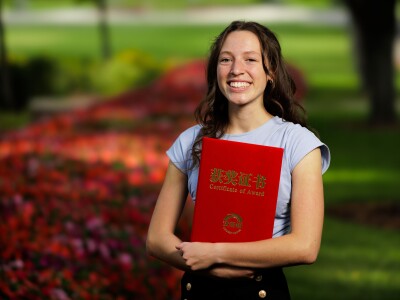Genetic analysis provides critical information for future conservation
Most humans have never seen a clouded leopard in person. Experts call them the modern saber-tooth cat because of their massive canines, but the medium-sized “felids” are quite adorable, with beautiful cloud-spotted coats and short stalky legs.
But like so many other apex predators, global populations of clouded leopards are declining due to habitat destruction, poachers and other threats. Both species of the wild cat —the Sunda clouded leopard and the Mainland clouded leopard — are on the endangered species list, with global populations of roughly 5,000 of each.
Researchers from BYU and the Smithsonian Conservation Biology Institute are doing their best to help protect the future of the creatures by studying their genetics. As detailed in a new study, the team has sequenced the entire genome of both species for the first time, and in doing so they’ve learned something critical they didn’t expect: the clouded leopard diverged into two separate species much earlier than previously thought.
According to the new genomic analysis, published in the journal iScience, clouded leopards diverged 5.1 million years ago, much earlier than previous estimates of 1.5 to 2 million years ago. This divergence is older than the divergence between leopards and lions and even older than the divergence between jaguars and the common ancestor to leopards and lions.
“The deeper the species divergence, the more genetic differences are accumulated over time. If two species diverged 5 million years ago versus 2 million years ago, that just gives a lot more time for the genome to accumulate unique variation,” said BYU professor and study author Paul Frandsen. “That’s critical for conservation because we want to maintain that unique variation within the species.”
For nearly 100 years, until 2006, the two species were considered a single species. The new BYU-Smithsonian research confirms those 2006 studies, which provided evidence that the two species of clouded leopard are genetically distinct. The findings also establish a valuable foundation for conservation managers of both captive and wild clouded leopards because they establish key differences in genetic variation between the two species. Understanding the present state of genetic variation and diversity of the clouded leopards is critical because it is connected strongly to their ability to adapt to changing environments.
“This BYU study is important to the future conservation of the species because while we knew that there were two separate species of cloud of leopard, we did not realize exactly how distinct they were and how long ago in time they diverged,” said Laura Shipp, a zookeeper who cares for two clouded leopards at the Loveland Living Planet Aquarium. “The fact that they're so distinct changes the priorities and how we approach the problem of saving both species.”

Researchers generated the genome assemblies using samples from one captive mainland clouded leopard and one wild Sunda clouded leopard. Clouded leopards are highly elusive and their ecology and habitat requirements are not well known. They are also excellent climbers, using trees primarily as resting sites. This is all to say that it was extremely difficult to track down a Sunda clouded leopard in the wild to get a tissue sample.
Thanks to colleagues in the UK and the Sabah Wildlife Department of Malaysia, who were able to capture a wild Sunda cloud leopard, the team got the samples they needed. Frandsen and former BYU undergrad Madeline Bursell then led the effort to assemble and annotate the two clouded leopard genomes.
“There are people in the wild monitoring the species and there’s also us who are working behind computers, but also doing important work to use their genomes to understand their genetic diversity to have a baseline for their future” Bursell said. “Hopefully we keep them around forever because they’re very unique and special and they deserve to be here.”
Bursell said another major contribution of the genome analyses was that it allowed the researchers to complete the entire phylogenetic tree of all Pantherinae, which includes leopards, tigers, lions, snow leopards, jaguars and the two clouded leopard species.
BYU, the Smithsonian and the Baylor College of Medicine were the core partners in the study, with Bursell playing a key role in pushing the project forward. Before graduating from BYU in April 2021 with a degree in genetics, genomics and biotechnology, Bursell spent a summer at the Smithsonian on a College of Life Sciences funded internship. Since then, she has been interning there and is the lead author on the paper announcing the genome sequencing of the two clouded leopard species.
“We mentor a lot of students and Madeline is a shining example of the mentoring environment at BYU,” Frandsen said. “We also hired students to do illustrations as part of the paper, so from a BYU standpoint it’s been a really cool project because we’ve been able to integrate a lot of what BYU really does well.”
Shipp, who is also a BYU alum, said Frandsen and Bursell’s work is going to make a significant difference in the conservation of clouded leopards.
“It's giving us really key knowledge that we can build upon about what genetic variation is out there and where we go from here, what comes next, and how we can preserve what variation we have,” she said.
“These two species still look really similar and if one of them ran past me in the wild, there’s no way I would be able to tell you which one it was,” Frandsen said. “But what we see with our eyes is not always a clear picture or what is going on genetically. This work highlights the importance of using genetic data to inform conservation.”









